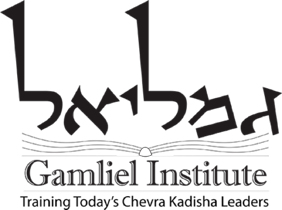FAMILY MATTERS
By Rochel U. Berman
Friends for a Holy Journey
As I pull back the baby’s pink-and-white blanket, I see she is scantily dressed in a short-sleeved white undershirt, a disposable diaper and bright pink socks. She looks cool and comfortable on this hot summer day. Her head is covered with a slight fuzz of hair, a telltale sign of recent chemotherapy. The treatment, which prolongs life, was not successful in this instance. The baby, 18 months old, is dead.
How do I, a stranger, happen to be in such intimate contact with this deceased child? I am a member of my community’s hevra kadisha, the Jewish burial society. We are a disparate group, men and women, young and old, who in our everyday lives are doctors, lawyers, teachers, students, business people and homemakers. Our common bond is the volunteer work we do in preparing the dead for their final journey in accordance with Jewish law.
The myths and misconceptions surrounding the work of the hevra kadisha are rampant. A friend of mine who grew up in Israel told me that as a child she recalled being warned by older playmates who wanted to frighten her that “the hevra kadisha will get you!” as though they were the incarnation of the bogeyman.
Prior to becoming involved in the hevra kadisha, like most people I had little knowledge about tahara procedures — the washing and ritual purification. My first experience with death occurred when my father passed from this life at the age of 95. Following his demise, he was whisked away and within 12 hours I was standing at his graveside staring at his casket asking myself, “I wonder what happened to his body from the time he died to the interment?” The images I conjured up were vague and obscure. My uninformed vision of the hevra kadisha was a group of little hobgoblins, asocial, asexual, who worked in the dark and never appeared in the light of day.
Thinking about them at that moment was chilling and only intensified my grief. How different I felt several years later when my mother-in-law died and was prepared for burial by hevra members with whom I serve. While I was still defenseless to death’s intrusion, the hobgoblins of the past were replaced by whole people — individuals who shared my grief and for whom I knew it was a privilege to perform this time-honored task.
Jewish law prescribes that a town or village is under strict obligation to bury its inhabitants, as well as anyone who died near its borders. Our tradition speaks forcefully to the importance of a community‑based hevra. In the Middle Ages, European Jewish communities established a separate tahara house at their cemeteries where the deceased were washed and dressed. The first hevra in America, called Hesed V’Emet (Charity and Truth), was formed in New York in 1802.
From birth to death, religion imbues milestones in the life cycle with spiritual significance. Even after the soul departs, the body retains its sanctity just as the Torah Ark retains its holiness after the scroll is removed. Protecting the dignity of the deceased is a principal concern of the members of the burial society.
The three of us who have volunteered to perform this final act of kindness have been members of the burial society for several years. Yet the responsibility before us on this bright summer morning is more awesome than most. The death of a child so young invades the reasonable order of things. I fantasize that this little girl is only momentarily in repose and will soon awake to cry, to laugh, to be comforted.
The illness has left her thin and frail and I approach the preparation table with hesitation as I carefully place a fresh sheet over the body. In accordance with Job 1:21, “Naked I come out of my mother’s womb and naked I shall return,” we remove the clothing prior to the tahara.
My brief struggle with the adhesive tabs of the disposable diaper is made more difficult by the memory of recently performing this duty for my young grandson. The attention usually makes him gurgle and sends his chubby legs into perpetual motion. The contrasting stillness and silence is striking. It makes me feel vulnerable. Two of us delicately wash and dry the child while the third person solemnly recites biblical passages which assure respect for the human body even in death. The prayers serve still another purpose. They create a sanctuary in which to perform this commandment and give us the strength and courage to proceed with this difficult mission.
The final purification requires us to pour a continuous stream of water over the deceased. After the body is dried, and in keeping with the medieval Jewish custom, we spread a mixture of egg white and vinegar over her forehead. The hand-sewn, child-size shrouds in which we dress her are too large. I meticulously tuck and fold the shrouds so that the excess fabric will not obliterate the definition of her tiny frame. While the lightness of her body eases the physical task, it intensifies the emotional burden.
As I cradle the body in my arms and gently lower it into the casket, I am reminded of the million‑and‑a‑half Jewish children, some younger than this one, some not much older, who perished in the Holocaust and were buried in mass graves without the benefit of this act of loving-kindness. I mourn their tragic end along with the numbered days of this small child.
Prior to placing the lid on the casket, we cover her eyes and mouth with pieces of broken earthenware, a symbolic reminder of human frailty. We sprinkle earth from Israel over the shrouded body, a concrete connection with the land of our ancestors. Finally each of us offers a silent personal prayer in which we ask forgiveness of the deceased for any sins of commission or omission which may have violated the commandment to respect the dead.
Tucked away in the corner of the room, I notice a large shopping bag filled with toys—the child’s personal effects that accompanied her from the hospital to the funeral home. Perched on top is a robust teddy bear whose bulk is straining the sides of the bag. Did this fuzzy stuffed animal brighten her final days? Will it be a painful reminder to the bereaved family or will it help them to remember, to mourn and eventually to heal? I desperately want to tell the parents of the care we took with their cherished child, but decide that this would be an invasion of their private grief. Instead, I hope that the personal letter of condolence customarily sent by our hevra will assure them that their baby was prepared for burial with the utmost reverence, in accordance with the Jewish tradition.
Because most people have a need to distance themselves from death, I am frequently asked “Why do you do this?” “Isn’t it depressing?” “How did you get started?”
My motivations for becoming involved were a combination of the practical, personal and philosophical. There was a need for additional women to do taharot. Since my husband was already a member of the hevra, I thought I, too, would like to offer my services. While I was filled with anxiety and trepidation the night before I did my first tahara., I found it to be profoundly rewarding. Despite a demanding career and commitments to home and family, I rarely decline an opportunity to do a tahara. Participating in the egalitarian customs and ceremonies of burying the dead reaffirms my own philosophy of life.
When the technology is turned off and the technicians can do no more, when death comes, what remains is a sense of incompleteness—a need for spiritual closure. It is uplifting to know that at this venerable moment I was able to perform the final act of love.
The dazzling sunlight that greets us as we leave the funeral home is in sharp contrast to the somber task we have just completed. Sharing this trying experience has created a profound sense of sisterhood among the three of us. We are deeply saddened, yet we are comforted by the knowledge that this child, whose time on earth was so preciously short, departed gently.
Outdoors, we ritually wash our hands as a sign of separation from the dead and head back to resume our lives among the living.
Rochel U. Berman was a member of the Congregation Rosh Pinah Chevra Kadisha, serving Westchester County in New York for18 years. She is at work on a book about tahara—the final act of loving kindness.
HADASSAH MAGAZINE — OCTOBER 1996
Posted with permission of Hadassah Magazine and Rochel Berman – April 2003

